Grace Elliot's Blog: 'Familiar Felines.' , page 21
October 17, 2012
Unofficial London - A Very Public Convenience.
 Where did the expression, 'to spend a penny', come from?
Where did the expression, 'to spend a penny', come from?What has 'bumf' to do with toilet paper?What is the origin of the word, 'sewer'?'
Exiting Bank tube station, you emerge from into the daylight within sight of two of London's grandest landmarks: The Bank of England and the Royal Exchange. Both are immense and breathtaking, and are also associated with some most unusual history. Today's blog post takes inspiration from the Royal Exchange and its lavatorial connections.
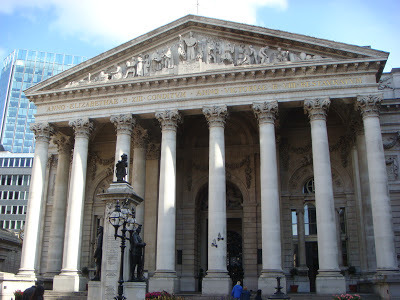 The Royal Exchange. Did you know that the first public conveniences to charge were sited beneath the Royal Exchange? The fee was one penny - hence the euphemism: "To spend a penny." Use of the urinals was free, but a stall-door was unlocked by a coin-operated locking mechanism designed by magician and illusionist, John Nevil Maskelyne.
The Royal Exchange. Did you know that the first public conveniences to charge were sited beneath the Royal Exchange? The fee was one penny - hence the euphemism: "To spend a penny." Use of the urinals was free, but a stall-door was unlocked by a coin-operated locking mechanism designed by magician and illusionist, John Nevil Maskelyne. 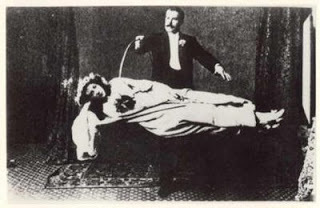 Illusionist John Maskelyne - who designed the coin-activated
Illusionist John Maskelyne - who designed the coin-activatedlock on toilet doors.However, the subject of alerting people to the location of 'public waiting rooms' (another euphemism!) for gentleman was considering so uncomfortable, that it was unthinkable to advertise a 'ladies'. It wasn’t until many years later that the first 'ladies' sign appeared on Londonstreets.
Public conveniences had been around for centuries before this. Perhaps the most well known medieval example was the 'House of Easement' or 'Long House'. This boasted 128 seats in two rows (one for men, the other for women) and was erected by the Mayor of London, Richard Whittington (of pantomime cat fame) in 1419. Use of the toilets was free but no toilet paper was provided. Boys patrolled up and down the ranks of toilets selling torn up pamphlets or 'bum fodder' and it is from this that the word 'bumpf' originates.
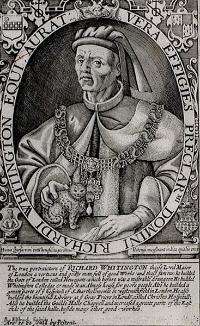 Richard Whittington - the 'cat' in the engraving, was first
Richard Whittington - the 'cat' in the engraving, was firstdrawn as a skull - but because of Dick's popular association with
his cat the artist changed it - hence the slightly odd shape!This 'House of Easement' had the simplest flushing system of all - the tide! Built over the banks of the Thames, the tidal river swept the refuse away out to sea, the journey from riverbank to open water taking between three and eleven weeks. In fact, the word 'sewer' is derived from the 'seaward' i.e. taking the excrement to the sea!
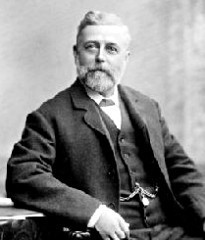 Thomas Crapper.The 'public necessaries' beneath the Royal Exchange were built in 1854 in response to a Public Health Act. The man responsible for their design, George Jennings, declared:
Thomas Crapper.The 'public necessaries' beneath the Royal Exchange were built in 1854 in response to a Public Health Act. The man responsible for their design, George Jennings, declared:"The civilisation of a people can be measured by their domestic and sanitary appliances."
Jennings publically crusading for more public toilets which he called 'halting stations.' A pioneer of water closet construction, his rival was the perhaps more well-known Thomas Crapper, whose name has long since become synonymous lavatories. Indeed, at this time there were thousands of Victorian toilet patents, of which Crapper held just nine. But it was Jennings who installed a splendid gentlemen's lavatory system in John Wesley's Methodist chapel.
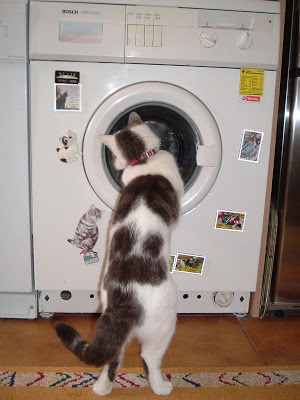 Widget is a big fan of cleanliness - and regularly checks
Widget is a big fan of cleanliness - and regularly checksstandards are being maintained. In one of his famous sermons, Wesley exhorted the congregation that:
"Cleanliness is indeed next to Godliness,"
Which must have been music to Jennings ears as he designed ceramic urinals with a helpful bull's eye target, hand basins dressed with marble and wooden cubicles not unlike confessional boxes? The porcelain handles on the pull chain were adored with the helpful instruction, 'pull and let go', perhaps an exhortation to cleanse the soul as well as the body.
Published on October 17, 2012 02:46
October 10, 2012
Unofficial London - Going Underground.
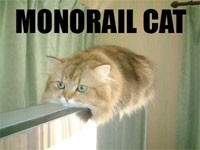 How did the London Underground get nicknamed 'The Tube'?Why did the underground frighten horses?
How did the London Underground get nicknamed 'The Tube'?Why did the underground frighten horses?What is the origin of the announcement: "Mind the gap"?
In this, the third post on my exploration of the area around Bank station, London, I focus on some startling facts about the history of the underground.
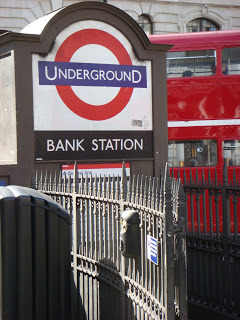 Mind the Gap.
Mind the Gap. My day out in London started at Bank tube station. What surprised me as I emerged up onto street level was the amazing historic buildings within sight of the station: The Bank of England, The Royal Exchange and the Mansion House. Apparently the Victorian engineers were also overawed, and afraid of being sued by wealthy property owners if their tunnels caused subsidence.
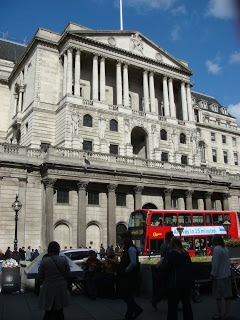 The Bank of England -
The Bank of England -neighbouring Bank Tube station.Their solution was the divert the route of the tunnels to avoid going directly beneath these important buildings. This meant around Bank, there are some of the sharpest bends in the tube network, and some speculate that one particular sharp turn was to avoid tunnelling through the Bank of England's vaults. All this meant that long curved platforms were necessary, which led to substantial gaps in places between platform and carriages. It is because of this that often repeated public announcement, "Mind the gap" first came into being.
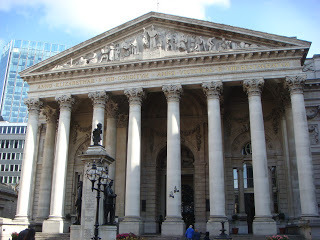 The Royal Exchange - across the road from Bank tube station.Bringing the House down.
The Royal Exchange - across the road from Bank tube station.Bringing the House down. Work on the tube network began in 1860 and the stretch of the Metropolitan line between Paddington and Farringdon, was opened on 9 January 1863 to become the world's first underground railway.
To minimise costs and because no one had ever undertaken such a thing before, the initial method of construction was to dig a deep trench, lay down the track, then build a brick arch over it to form a tunnel and then cover everything over. This worked well when the proposed route lay parallel to road, but between Paddington and Bayswater, houses were orientated the wrong way, at ninety degrees to the direction of the track. In addition, on Leinster Gardens, two grand houses stood in the path of excavations.
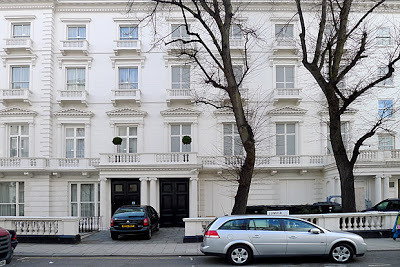 Leinster Gardens - the fake facade is behind the silver car -
Leinster Gardens - the fake facade is behind the silver car -note the blocked out ground floor windows.The solution was to demolish the houses to allow excavation of the tunnel, then rebuild the facades to conceal the hole behind, which as left open, to allow the train drivers to vent their engines steam - much to the alarm of horses passing by on the road.
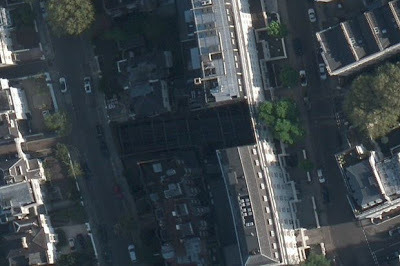 Leinster Gardens from the air (courtesy of Bing maps)
Leinster Gardens from the air (courtesy of Bing maps)Note the fake facade and tube lines beyond. Because the system was built as cheaply as possible, rather than design new locomotives, pre-existing steam engines were used. Of course, the underground tunnels soon filled with thick coal smoke, as The Times commented:
"A journey from King's Cross to Baker Street is a form of torture which no person would undergo if he could conveniently help it."
In counter-attack the underground's marketing people quickly came up with a story that the smoky atmosphere was actually beneficial to asthmatics! But this propaganda didn't convince the train drivers who grew thick beards to try and filter out the soot. Eventually, common sense prevailed and the engines were modified so the exhaust could be collected and vented in a big blast when the trains passed close to the surface.
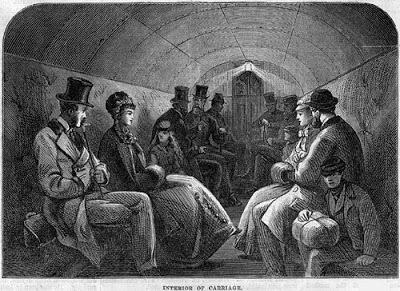 The Tower subway carriage of 'Tube'-
The Tower subway carriage of 'Tube'-Claustrophobic, hot, gloomy and smelly.The Tube under the Thames. In 1870 the first deep level stretch of the underground was dug between Tower Hill and Tooley Street and passed under the Thames. Because there was no way to ventilate the tunnel as it ran under the river, and so rather than use steam engines, a special windowless carriage was developed, hauled through this section by a cable. This became known as 'The Tube' - a name which stuck for the rest of the network.
The section of the network was, by all accounts, not a good place for a claustrophobe to visit as recorded by Charles Dickens, jr:
"..there is not much head-room left, and it is not advisable for any but the very briefest of Her Majesty's lieges to attempt the passage in high-heeled boots, or with a hat to which he attaches any particular value."
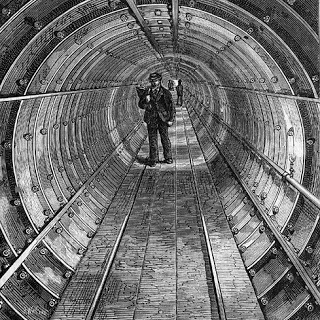
Traversing this section sounds deeply unpleasant: the tube was hot, humid, the cable mechanism very noisy, the travelling compartment windowless with gloomy gas-lights and to top it all - the carriage frequently got jammed in a dip in the middle of the route. After just three months the train was scrapped and the tunnel converted to pedestrian use.
I went down and down between two dingy walls until I found myself at the round opening of the gigantic iron tube, which seems to undulate like a great intestine in the enormous belly of the river.Contemporary account by Edmondo De Amicis.
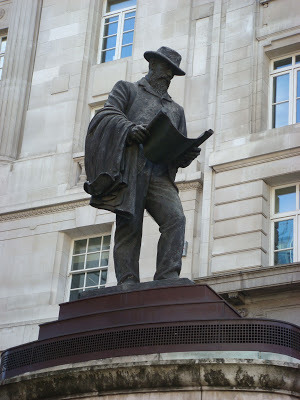 Statue of J H Greathead, near Bank station.The Second Tunnel under the Thames.
Statue of J H Greathead, near Bank station.The Second Tunnel under the Thames.James Henry Greathead along with another engineer, Peter Barlow, developed a device that successfully drilled much larger bore tunnels. Their device consisted of an iron cylinder, just over 7 ft in diameter, fitted with screw jacks that allowed it to be inched forward. As the labourers excavated beneath the safety of the shield, so the device was advanced and a permanent lining of cast iron segments fitted in place behind them. Over time Greathead refined the device to include the use of compressed air and hydraulic jacks, which are now standard features of tunnel construction.
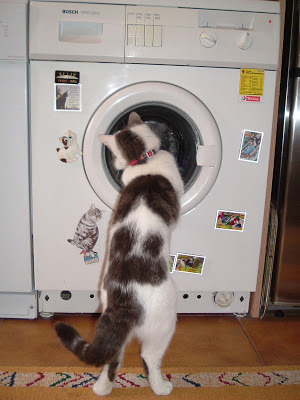 Widget says: "Does this lead to a tunnel - and are there
Widget says: "Does this lead to a tunnel - and are therecat biscuits at the end of it?"
And finally, a Victorian wonder the underground system may have been, but sometimes it seems as though it's still stuck in Victorian times - with the heat, congestion and general state of decay. What are your impressions of the underground: a system to be proud of or something to be tolerated?
Published on October 10, 2012 02:25
October 3, 2012
Unofficial London - At 6's and 7's.
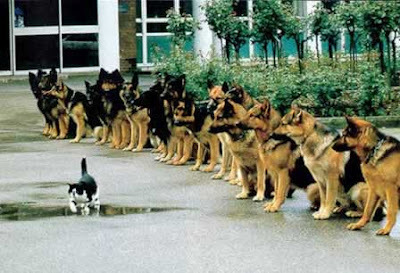 What is the origin of the expression,
"At sixes and sevens"
- an idiom meaning a state of confusion or disarray?
What is the origin of the expression,
"At sixes and sevens"
- an idiom meaning a state of confusion or disarray?It wasn’t something I had thought about until a recent trip to the environs of Bank tube station, London. My meanderings led me to the Guildhall Art Galleryand an exhibition, "Butcher, Baker and Candlestick Maker", about the 850 year history of Livery Companies. But the inspiration for this post came later when I mentioned my visit to a fellow vet, as we removed a diseased spleen from a 50 kg German Shepherd! (*1)
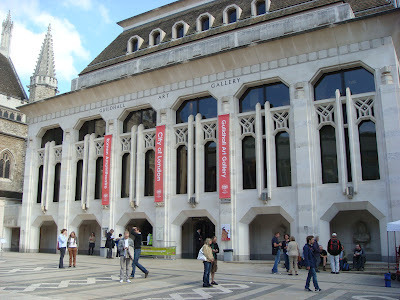 The Guildhall Art Gallery, London.Livery companies date back to medieval times as a means of controlling quality, price, wages and working conditions. From the Saxon word "gegildan", meaning to pay, guilds were set up to regulate standards. Groups, or guilds of like-minded men and women (*2) met together, often in churches, and made it their business to care for the orphans and widows of their members; hence the long tradition of charitable activity. The monarch of the day also became involved, granting Royal Charters to Livery Companies (as a means of raising money for the treasury!). By the early 16th century 48 such Livery Companies existed.
The Guildhall Art Gallery, London.Livery companies date back to medieval times as a means of controlling quality, price, wages and working conditions. From the Saxon word "gegildan", meaning to pay, guilds were set up to regulate standards. Groups, or guilds of like-minded men and women (*2) met together, often in churches, and made it their business to care for the orphans and widows of their members; hence the long tradition of charitable activity. The monarch of the day also became involved, granting Royal Charters to Livery Companies (as a means of raising money for the treasury!). By the early 16th century 48 such Livery Companies existed. 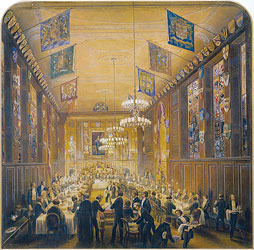 Clothworkers Hall - Dinner 1856Many guilds had their headquarters in large houses or halls, often bequeathed by wealthy members. The halls were lavishly decorated, but sadly most were destroyed in the Fire of London, 1666. Indeed, the Guildhall built around 1411, was the only secular stone building to survive the great fire.
Clothworkers Hall - Dinner 1856Many guilds had their headquarters in large houses or halls, often bequeathed by wealthy members. The halls were lavishly decorated, but sadly most were destroyed in the Fire of London, 1666. Indeed, the Guildhall built around 1411, was the only secular stone building to survive the great fire. So what has this to do with "At 6's and 7's"?
Of the 48 guilds, a list of precedence was drawn up, based on wealth and political power. Competition to be high on the list was fierce.
The Great Twelve Livery Companies.
#1 Mercers#2 Grocers
#3 Drapers
#4 Fishmongers
#5 Goldsmiths
#6 Merchant Taylors
#7 Skinners
#8 Haberdashers
#9 Salters
#10 Ironmongers
#11 Vintners
#12 Clothworkers.
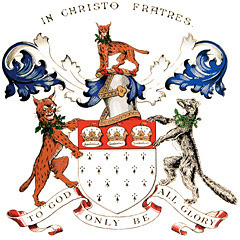 The Skinners - Coat of Arms. In the middle ages, the Lord Mayor of London held an annual parade on the Thames, during which the guilds sailed past on barges [incidentally, this is where 'float' originates. The barges 'floated' past and the term became associated with processions.] However, events came to a head in 1484 when rivalry between the Merchants Taylors and the Skinners erupted over which of them had the honour sixth place. They treated the Lord Mayor's parade as private boat race, fighting broke between the two barges and lives were lost. It took nearly a century for a compromise to be reached, when in 1484 the Mayor, Robert Billesdon, proposed that Merchant Taylors and Skinners should alternate sixth and seventh place, swapping over each Easter.
The Skinners - Coat of Arms. In the middle ages, the Lord Mayor of London held an annual parade on the Thames, during which the guilds sailed past on barges [incidentally, this is where 'float' originates. The barges 'floated' past and the term became associated with processions.] However, events came to a head in 1484 when rivalry between the Merchants Taylors and the Skinners erupted over which of them had the honour sixth place. They treated the Lord Mayor's parade as private boat race, fighting broke between the two barges and lives were lost. It took nearly a century for a compromise to be reached, when in 1484 the Mayor, Robert Billesdon, proposed that Merchant Taylors and Skinners should alternate sixth and seventh place, swapping over each Easter. 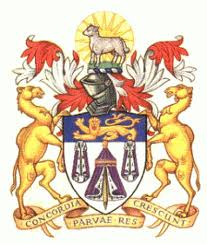 Merchant Taylors - Coat of Arms.It is possible that the expression, 'at sixes and sevens' predates this - in 1380 Geoffrey Chaucer mentions, "to set the world on six and seven," in Troilus and Criseyde. He uses it in this context to mean "to risk ones life" or "to hazard the world." However it seems likely that the Merchant Taylors/ Skinners dispute confirmed the idiom in the English language.
Merchant Taylors - Coat of Arms.It is possible that the expression, 'at sixes and sevens' predates this - in 1380 Geoffrey Chaucer mentions, "to set the world on six and seven," in Troilus and Criseyde. He uses it in this context to mean "to risk ones life" or "to hazard the world." However it seems likely that the Merchant Taylors/ Skinners dispute confirmed the idiom in the English language. 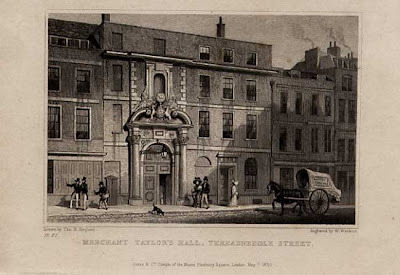 Merchant Taylors hall, Threadneedle Street.(*1) My colleague mentioned he went to Merchant Taylors school, Northwood. He recounted the dispute between the Taylors and Skinners, and how lives were lost on the Thames- and this whetted my appetite to find out more!
Merchant Taylors hall, Threadneedle Street.(*1) My colleague mentioned he went to Merchant Taylors school, Northwood. He recounted the dispute between the Taylors and Skinners, and how lives were lost on the Thames- and this whetted my appetite to find out more! (*2) Most companies originally admitted women to their ranks, but this was stopped around 1800.
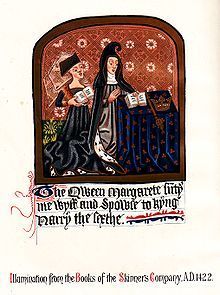 Queen Margarete of Anjou, wife of King Henry VI, is entered in the roll of the fraternity of Our Lady under date XV year of King Edward IV (A.D. 1475)
Queen Margarete of Anjou, wife of King Henry VI, is entered in the roll of the fraternity of Our Lady under date XV year of King Edward IV (A.D. 1475)
Published on October 03, 2012 02:05
September 26, 2012
Unofficial London - What's In a Name?
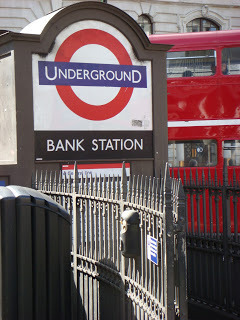 Author's own photo. One sunny day I decided to investigate the history within walking distance of London's, Bank tube station - and after the initially eye-catching buildings such as the Bank of England and Royal Exchange... next to strike me were the street names.
Author's own photo. One sunny day I decided to investigate the history within walking distance of London's, Bank tube station - and after the initially eye-catching buildings such as the Bank of England and Royal Exchange... next to strike me were the street names. 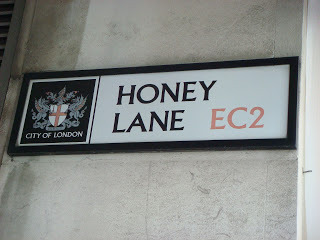
Heading out of Bank station towards St Pauls Cathedral, I walked along Cheapside, passing side roads with names such at Bread Street, Honey Lane and Ironmonger Lane.
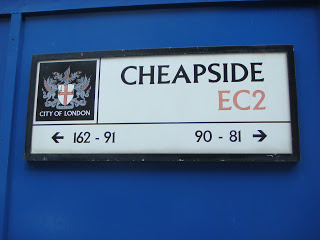 Cheapside.
Cheapside.Cheapside was established in 1104, following the path of a Roman road. In medieval times the word 'Cheap' meant, market, and as the widest road in the city, it was a popular trading place. The roads leading off it were named for the produce they sold, hence Milk Street, Poultry et.c
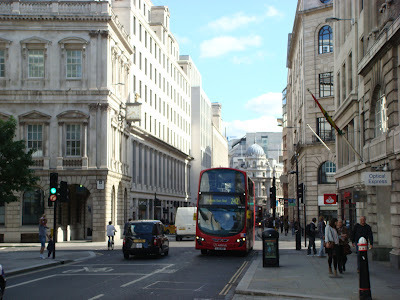 Modern Cheapside (Saturday 22 September 2012)Because Cheapsidewas regularly thronged with people, it was also prime site for a pillory - or place to publicly humiliate those who had broken the law. The offender was fastened into the pillory by their neck and wrists, on a platform so everyone had a good view. [Stocks were subtly different, the villain being fastened only by their ankles.] The crowd then pelted the wrong-doer with anything that came to hand, from rotten eggs and vegetables, to blood and guts from the nearby slaughterhouses. Concerns about public disorder meant the pillory was abolished as a punishment in 1837.
Modern Cheapside (Saturday 22 September 2012)Because Cheapsidewas regularly thronged with people, it was also prime site for a pillory - or place to publicly humiliate those who had broken the law. The offender was fastened into the pillory by their neck and wrists, on a platform so everyone had a good view. [Stocks were subtly different, the villain being fastened only by their ankles.] The crowd then pelted the wrong-doer with anything that came to hand, from rotten eggs and vegetables, to blood and guts from the nearby slaughterhouses. Concerns about public disorder meant the pillory was abolished as a punishment in 1837. 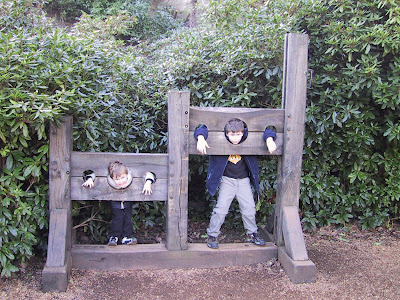 My sons in the pillory! Warwick Castle 2002. Bread Street
My sons in the pillory! Warwick Castle 2002. Bread StreetBread Street got its name when in 1302, a decree was passed that bread must not be sold door to door, but in an open market. The bakers principle market was established here and hence lent its name to the street.
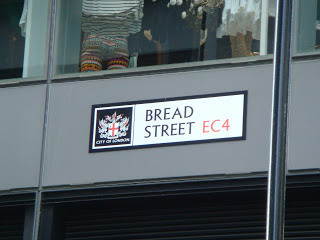 Bread Steet - now home to a Gordon Ramsay restaurant
Bread Steet - now home to a Gordon Ramsay restaurantand a branch of Gap.The poet, John Milton, author of Paradise Lost and described as "the greatest British writer", was born here. Also, the commander of the First Fleet, founder and first Governor of Australia, Admiral Arthur Phillip was baptised in All Hallows Church, Bread Street in 1738.
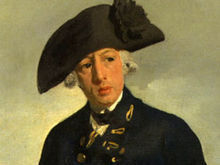 Admiral Arthur Phillip.By happy coincidence, I am currently reading "The Gilded Lily" by Deborah Swift and the central characters live in Bread Street for a while. It feels such a lovely connection to history to have such believable characters treading through snow, bringing the area to life.
Admiral Arthur Phillip.By happy coincidence, I am currently reading "The Gilded Lily" by Deborah Swift and the central characters live in Bread Street for a while. It feels such a lovely connection to history to have such believable characters treading through snow, bringing the area to life. 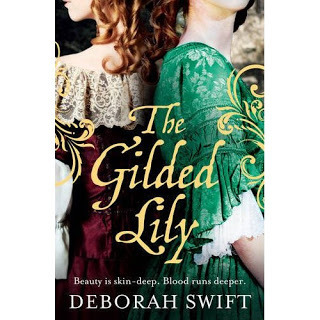 Sherborne Lane. And finally, although London streets were named for the trade that took place there, sometimes this backfired. 'Sherborne Lane' - quaint as it sounds, conjuring images of clear running water, (named from the Dorset town Sherborne, which itself was derived from the Saxon word for 'clear stream') was actually a cover up, created by the 17th century Protestants to hide a much cruder descriptive name.
Sherborne Lane. And finally, although London streets were named for the trade that took place there, sometimes this backfired. 'Sherborne Lane' - quaint as it sounds, conjuring images of clear running water, (named from the Dorset town Sherborne, which itself was derived from the Saxon word for 'clear stream') was actually a cover up, created by the 17th century Protestants to hide a much cruder descriptive name.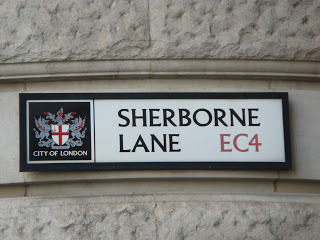
In medieval times an open sewer, rather than a stream, ran down the middle of the road, hence the much more colourful, "Shitteborne Lane." However this wasn’t the only street named after human refuse; the nearby Cloak Lane derived its origins from the Roman word for a sewer, cloaca.
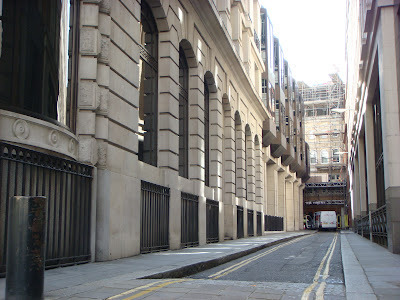 Sherborne Lane in the modern day - nice and clean. So when have you been surprised by the things around you or read a book with a setting familiar to you? Do leave a comment.
Sherborne Lane in the modern day - nice and clean. So when have you been surprised by the things around you or read a book with a setting familiar to you? Do leave a comment.
Published on September 26, 2012 02:33
September 19, 2012
Kensington Palace - At Home With The King.
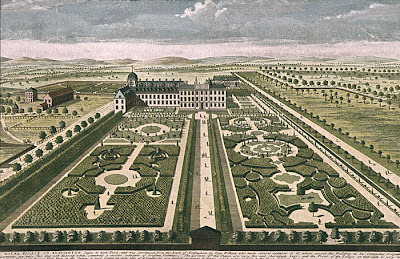 Kensington Palace and grounds - in its 18th century heyday.The surprising thing about Kensington Palace is its sense of intimacy. In last week's post I mentioned the Grand Staircase which is awe-inspiring but because of the cheeky, boldness of the Georgian mural, rather than its scale. At the top of the stairs, you turn right to enter the King's Presence Chamber - similar in size to a modern sitting room - rather than some huge, palatial chamber. However, this is where the comparison ends because the decoration is gorgeous and gaudy, leaving the visitor in no doubt they are in entering into a royal presence.
Kensington Palace and grounds - in its 18th century heyday.The surprising thing about Kensington Palace is its sense of intimacy. In last week's post I mentioned the Grand Staircase which is awe-inspiring but because of the cheeky, boldness of the Georgian mural, rather than its scale. At the top of the stairs, you turn right to enter the King's Presence Chamber - similar in size to a modern sitting room - rather than some huge, palatial chamber. However, this is where the comparison ends because the decoration is gorgeous and gaudy, leaving the visitor in no doubt they are in entering into a royal presence. 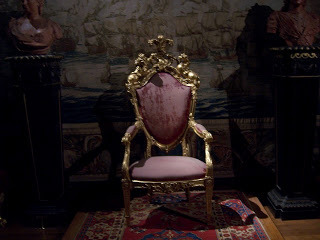 The gilded chair on which the King sat to recieve courtiers.
The gilded chair on which the King sat to recieve courtiers.This one belonged to George II's son, Frederick. But then the palace plays a trick - the deeper in you go the larger and grander the rooms become. In the Georgian court you either had to be a person of great importance, or else afford ever increasing bribes, to progress further.
The room that most took my breath away was the Cupola room. It is overwhelmingly opulent with its fantastically painted ceiling with the Star of the Order of the Garter as the centre piece. The décor was designed by William Kent (see last week's post) and his first commission for George I.
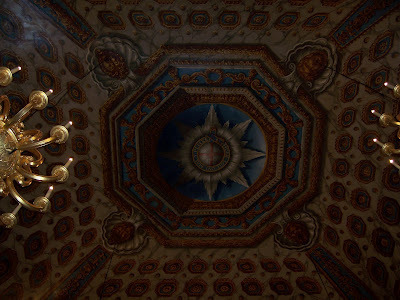 The ceiling in the Cupola Room
The ceiling in the Cupola Room (Thank you KP for allowing photos, but alas not flash photography.)Kent was a controversial choice because his art was different - and in time came to set the tone for the Georgian era. His greatest rival, Sir James Thornhill was most put out that Kentwon the job and his friends tried to undermine the young artist by casting aspersions on the quality of his work. They accused Kent of cutting costs by using inferior quality paint, especially when it came to the gilding - modern tests proved their claims to be false.
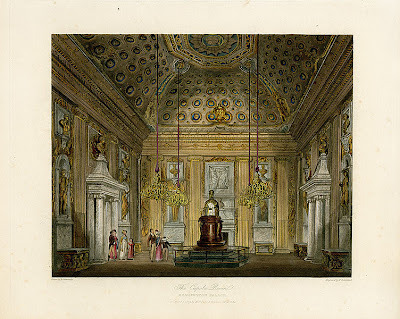 The Cupola Room - it was here Victoria was baptised.It was in the Cupola Room that the future Queen Victoriawas baptised. Her parents, the Duke and Duchess of Kent, were joined by the Prince Regent (later King George IV). It was George who decided the baby's name: Alexandrina (after the Russian Tsar) Victoria(after her mother).
The Cupola Room - it was here Victoria was baptised.It was in the Cupola Room that the future Queen Victoriawas baptised. Her parents, the Duke and Duchess of Kent, were joined by the Prince Regent (later King George IV). It was George who decided the baby's name: Alexandrina (after the Russian Tsar) Victoria(after her mother).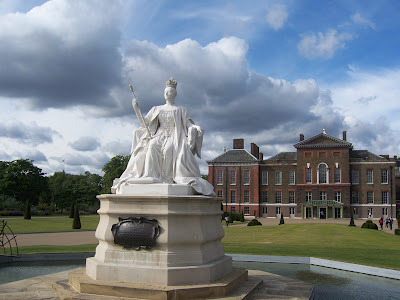 Statue of Victoria in her coronation robes, in front of Kensington Palace.
Statue of Victoria in her coronation robes, in front of Kensington Palace.Victoria was born at the palace. As the size of the rooms increases, so they become less personal. Although a grand chamber, the King's Gallery lacks a human feel, although many events of historical importance took place here. Today the gallery is hung with red damask, which in 1725 replaced the original green velvet.
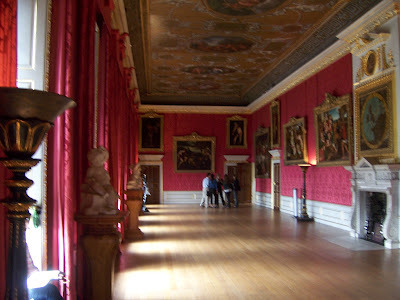 The King's Gallery, as it is today. The first monarch to use the gallery was William III - he received his spies and planned military campaigns here. He even had a wind dial linked to the room so he could see if the winds were set fair for an invasion fleet to cross the English Channel. He held his 50th birthday party here…and it was also said to be the room where he caught the chill that eventually killed him.
The King's Gallery, as it is today. The first monarch to use the gallery was William III - he received his spies and planned military campaigns here. He even had a wind dial linked to the room so he could see if the winds were set fair for an invasion fleet to cross the English Channel. He held his 50th birthday party here…and it was also said to be the room where he caught the chill that eventually killed him. 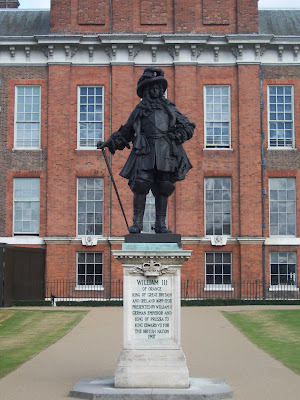 The statue of William III outside Kensington Palace. George I filled the gallery with fabulous paintings, of which the most famous are Tintoretto's "The Muses" and "Ester before Ahasuerus" and Van Dyck's portrait of Charles I. When King George inspected the room shortly after its completion he was said to be 'well pleased.'
The statue of William III outside Kensington Palace. George I filled the gallery with fabulous paintings, of which the most famous are Tintoretto's "The Muses" and "Ester before Ahasuerus" and Van Dyck's portrait of Charles I. When King George inspected the room shortly after its completion he was said to be 'well pleased.'
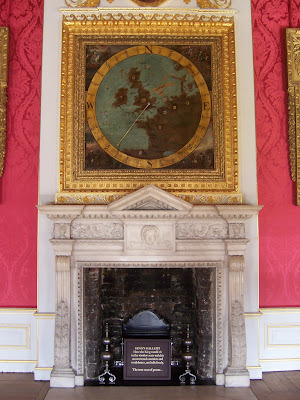 The fireplace in the King's Gallery. The future Queen Victoriawas born at Kensington Palace and as she grew into a young lady evidently she needed more space. Her mother's solution was to divide the king's gallery into three. The alteration caused consternation but Victoria records her delight in her journal:
The fireplace in the King's Gallery. The future Queen Victoriawas born at Kensington Palace and as she grew into a young lady evidently she needed more space. Her mother's solution was to divide the king's gallery into three. The alteration caused consternation but Victoria records her delight in her journal:"…three lofty, fine cheerful rooms. One...is my sitting room and very prettily furnished indeed."
Later in the 19th century the room was restored to its previous design.
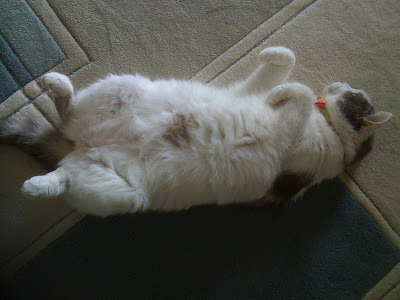 Widget says "A palace isn't a home without a cat...or five."
Widget says "A palace isn't a home without a cat...or five."
Published on September 19, 2012 02:51
September 12, 2012
Kensington Palace - Hotbed of Gossip.
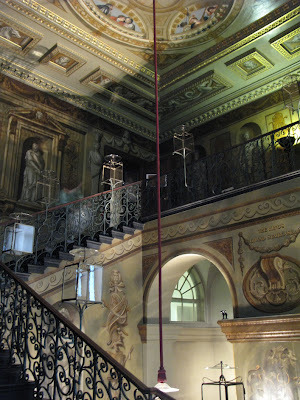 The King's Grand Staircase - all images on the walls are paint effects.
The King's Grand Staircase - all images on the walls are paint effects.Painted by William Kent 1726 and still stunningly modern.Inspired by Lucy Worsley's book, "Courtiers- the Secret History of the Georgian Court", my appetite was whetted to visit Kensington Palace. In particular, I wanted to see the King's Grand Staircase with its cheeky portraits of Georgian courtiers captured in a strikingly modern poses.
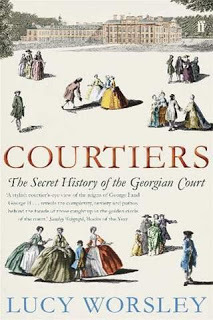 Lucy Worsley's captivating book
Lucy Worsley's captivating bookabout the intrigue in the Georgian Court.The sweeping mural that lines the staircase shows a snapshot of the royal household from Peter the Wild-Boy to the King's mistress, from Mohammed (the King's advisor) to the artist William Kent who painted the scene. To enter the hall and walk up the staircase, is spell-binding and I couldn't help but stop and stare in wonder. A vibrancy and sense of life oozes from the walls such that you can hear the scuttle of silk slippers and gossip whispered behind hands.
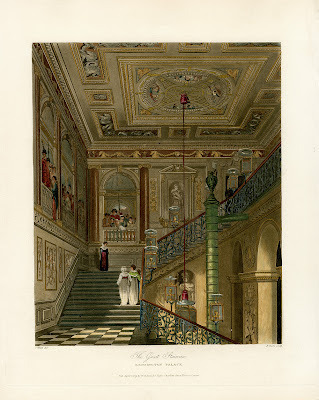 A better view of the Grand Staircase (portrait mural to the left
A better view of the Grand Staircase (portrait mural to the leftand at the head of the stairs.)There is a sense of fun, playfulness and intrigue about these portraits that must have caused huge a stir at the time. Added to that, I imagine being an outsider visiting George I, and seeing portraits of plotting courtiers, must have been terribly intimidating.
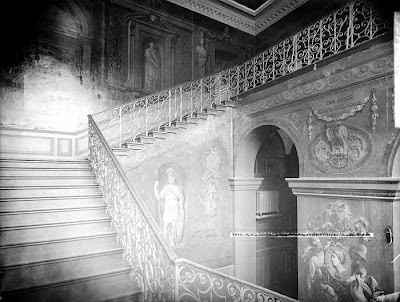 The Grand Staircase photographed around 1870, during Victoria's reign.
The Grand Staircase photographed around 1870, during Victoria's reign.Victoria was born at Kensington palace and it was here that she
learnt of her acsession to the throne.
Kensington Palace has undergone several reincarnations. In the 1600's it started out as a modest mansion, Nottingham House, in what was a rural landscape near London. When William III wanted a country retreat from the pressures of Whitehall, he found this the ideal solution, bought the property for 20,000 pounds and employed Christopher Wren to redesign it.
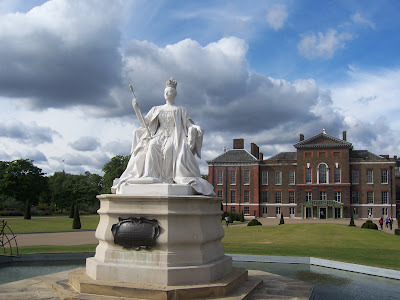 Queen Victoria in her coronation robes - set in front of Kensington Palace.
Queen Victoria in her coronation robes - set in front of Kensington Palace.The princess was living here when she learnt of her ascession to the throne.
Decades came and went and William's Kensington Palacefell into disuse until George I arrived from Germany. Even though the building was by now neglected in poor repair, the new king declared "I like it very much" and set about a raft of renovation and remodelling. The most stunning of these innovations was employing the controversial, up-and-coming artist, William Kent.
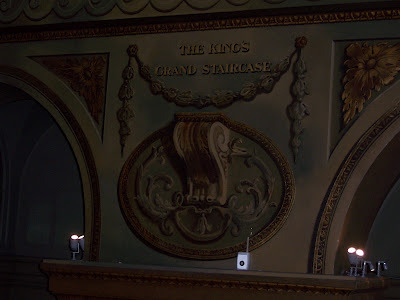 One of the trompe l'oiel paint effects on the staircase.
One of the trompe l'oiel paint effects on the staircase.Apologies for the under exposure. My reaction on seeing Kent's staircase mural was bewilderment. I was confused. The fresco style and trompe l'eoil effects so fresh and flirtatious that I thought I'd wandered into a modern interpretation of Kent's work. But no, these playful visual effects are the real thing! [Sadly, I have found no copyright free images to show you. All power to Kensington Palace for allowing photography, albeit without flash, so please excuse the underexposed photos from my pocket camera - but I wanted to give you a flavour of what I saw.]
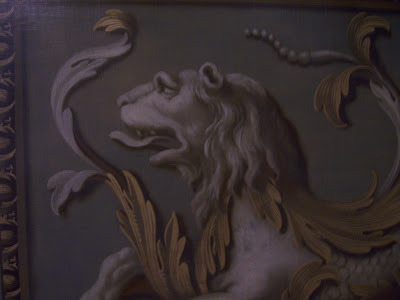 A pitiful photograph (by me!) of a wonderful paint effect - and this
A pitiful photograph (by me!) of a wonderful paint effect - and thisisnt even the main event (which are the courtiers - sadly too dark to photograph) If ever you have the opportunity to visit Kensington Palace, I can highly recommend it - worthwhile for the staircase alone! Kensington Palace has so many extraordinary stories of royalty and intrigue to tell - more of this in future posts when some of the gossip and scandal is revealed!
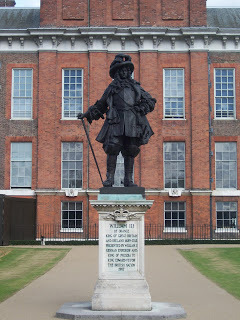 William III, Kensington Palace.
William III, Kensington Palace.
Published on September 12, 2012 02:53
September 5, 2012
Like Father, Like Son? - Zoophagy #2
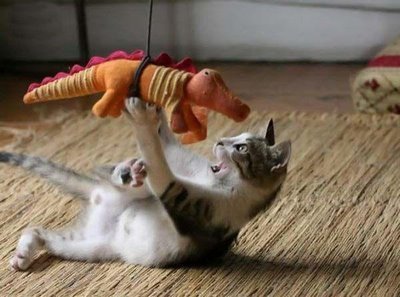 Photo courtesy of CatPictures.netLast week's post looked at the great British eccentric, Jack Buckland, on his mission to eat exotic animals - but what is perhaps not surprising is that his father was pretty weird too! The Very Rev. Dc. William Buckland (1784 - 1856) was a theologian, geologist and zoologist. Perhaps it's some measure of their family life, that it was William who introduced is son to the idea of zoophagy (see last week's post).
Photo courtesy of CatPictures.netLast week's post looked at the great British eccentric, Jack Buckland, on his mission to eat exotic animals - but what is perhaps not surprising is that his father was pretty weird too! The Very Rev. Dc. William Buckland (1784 - 1856) was a theologian, geologist and zoologist. Perhaps it's some measure of their family life, that it was William who introduced is son to the idea of zoophagy (see last week's post). In his early life, to prove his theory that bird droppings made excellent fertilizer, William used droppings to write the word "guano" over the lawn of his Oxford college. In due course when summer came, the letters were plain to read from a first floor window.
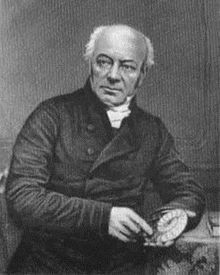 The Very Rev. Dc. William Buckland. Another indication of eccentricity was that one night Dc. Buckland was journeying to Londonwhen he got lost. His solution was to dismount from his horse, and trusting his extraordinary sense of taste, licked a handful of soil and proclaimed, "Uxbridge!" and then went on his way.
The Very Rev. Dc. William Buckland. Another indication of eccentricity was that one night Dc. Buckland was journeying to Londonwhen he got lost. His solution was to dismount from his horse, and trusting his extraordinary sense of taste, licked a handful of soil and proclaimed, "Uxbridge!" and then went on his way. A man of many talents, as well as being a theologian, Dc. Buckland was a palaeontologist and zoologist. Strange as it seems these disciplines are not unrelated because he studied fossil records and from that evidence proposed a 'gap theory' of creation.
This theory tried to reconcile the geological evidence that the earth was very old, with the genesis account of creation. Buckland proposed there had been two distinct periods of creation, separated by an unimaginable period of time. Indeed, in his early career he thought he'd found geological evidence of the biblical flood, work later built on by Louis Agassiz who suggested there'd been an ice age.
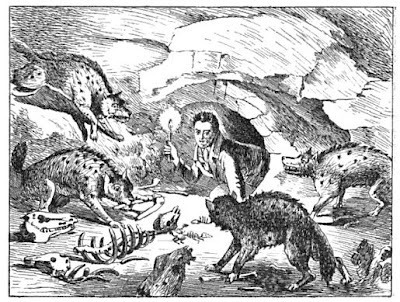 A contemporary cartoon of Dc.Buckland investigating a site of scientific interest. For Buckland's work with the fossil record he was made a member of the Royal Society but this eccentric's talents seem to know no end as he also became president of the Geological Society. He analysed fossilised bones to describe a creature he named "Megalosaurus", which later became recognised as the first scientifically catalogued dinosaur. As a measure of his eccentricity, Buckland preferred to do his excavations and digging wearing full academic dress!
A contemporary cartoon of Dc.Buckland investigating a site of scientific interest. For Buckland's work with the fossil record he was made a member of the Royal Society but this eccentric's talents seem to know no end as he also became president of the Geological Society. He analysed fossilised bones to describe a creature he named "Megalosaurus", which later became recognised as the first scientifically catalogued dinosaur. As a measure of his eccentricity, Buckland preferred to do his excavations and digging wearing full academic dress! 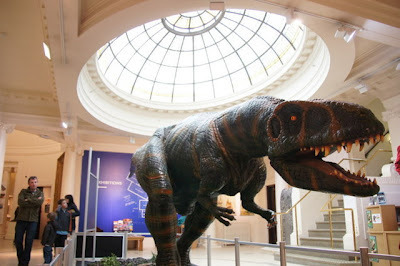 A model Megalosaurus - photo courtesy of Mike Pennington.Buckland married another fossil enthusiast, Mary. One story goes that she helped him decipher fossil footprints found in a lump of sandstone, by spreading flour over the kitchen table. She then let their pet tortoise walk across the table top and then Buckland was able to recognise the similarity of the footprint.
A model Megalosaurus - photo courtesy of Mike Pennington.Buckland married another fossil enthusiast, Mary. One story goes that she helped him decipher fossil footprints found in a lump of sandstone, by spreading flour over the kitchen table. She then let their pet tortoise walk across the table top and then Buckland was able to recognise the similarity of the footprint. It is perhaps a fitting end, that when William Buckland died, when the gravedigger started turning over the plot a layer of Jurassic limestone was discovered, which had to be cleared with explosives.
Another eminent geologist penned the following poem in tribute:
Where shall we our great Professor interThat in peace may rest his bones?If we hew him a rocky sepulchreHe’ll rise and break the stonesAnd examine each stratum that lies aroundFor he’s quite in his element underground
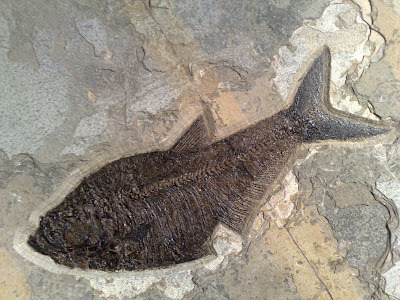 Fossil fish - photo courtesy of FairlyBuoyant. All of this leaves me wondering how much upbringing influences children? Do you think Jack would have been less interested in eating giraffes, if his father William had been more 'normal'? And what is 'normal' anyway?
Fossil fish - photo courtesy of FairlyBuoyant. All of this leaves me wondering how much upbringing influences children? Do you think Jack would have been less interested in eating giraffes, if his father William had been more 'normal'? And what is 'normal' anyway? Do leave a comment!
Published on September 05, 2012 02:55
August 29, 2012
Zoophagy - Victorians and Exotic Meat!
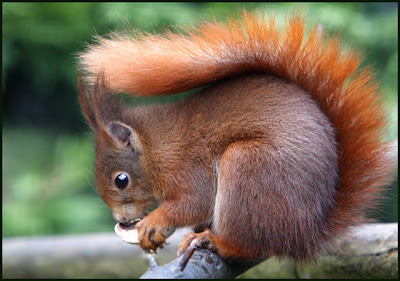 Red Squirrel.
Red Squirrel.Photo courtesy of British Wildlife Centre
Whilst on holiday on the Isle of Wight, I was lucky enough to see not one, but two, red squirrels. Granted, they aren't the brightest creatures on the planet (the first one ran alongside the car trying to outpace it, rather than escape up a tree!) but they win hands down in the cute stakes.
Sadly, red squirrels are becoming a rare sight in the UK, pushed out by the hardier and more aggressive grey squirrel. The later are a non-native species to Britain and were introduced in Victorian times by a naturalist, Frank Buckland - and this is where the zoophagy comes in - he imported grey squirrels to eat!
Zoophagy is the pursuit of eating animal flesh - and the more unusual the better.
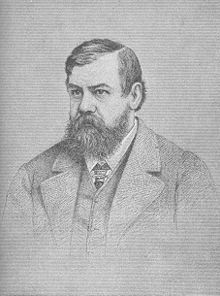 Doctor Frank Buckland.Born in 1826, Frank Buckland trained as a doctor, although his first interest was always natural history. To give him his due, he paid some attention to the medical profession because he noticed most nurses couldn’t read! He tested nurses with a medicine label.
Doctor Frank Buckland.Born in 1826, Frank Buckland trained as a doctor, although his first interest was always natural history. To give him his due, he paid some attention to the medical profession because he noticed most nurses couldn’t read! He tested nurses with a medicine label.What the label actually said was:'This lotion to be applied externally only.'
However the nurses' reply was:Two spoonfuls to be taken four times a day.'
Buckland eventually gave up his medical career to pursue his love of natural history, and became an expert in fish production. However, he took it as his personal mission to broaden the traditional 'roast beef' diet of the British and was a pioneer of zoophagy. Buckland regularly dined on delicacies such as mice in batter, horse tongue, squirrel pie and stewed mole (the latter reportedly tasted like "poo".) Indeed, Buckland had friends at the Royal Zoological Gardens (now London Zoo) who contacted him when an animal died, in case he wanted to eat it!
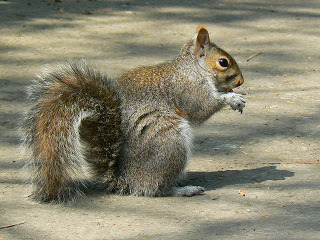 Non-native grey squirrel. Photo courtesy of Brian Marshall. In a quest to be even more adventurous, in 1859 he founded the Acclimatization Society. Their aim was to search for new and more exotic meats to eat, and at the society's inaugural dinner in 1862 the menu included roast kangaroo, boiled sea slug and grilled parrot. Such was his renown that it was said when he walked past:
Non-native grey squirrel. Photo courtesy of Brian Marshall. In a quest to be even more adventurous, in 1859 he founded the Acclimatization Society. Their aim was to search for new and more exotic meats to eat, and at the society's inaugural dinner in 1862 the menu included roast kangaroo, boiled sea slug and grilled parrot. Such was his renown that it was said when he walked past: "Elderly maidens called their cats indoors."
It was to broaden his dining options that Buckland came to import the grey squirrel form North America, with the subsequent disastrous decimation of our native red squirrels.
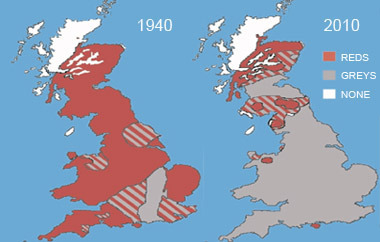 Distribution of red vs grey squirrels in the past 70 years.
Distribution of red vs grey squirrels in the past 70 years.Courtesy of British Red Squirrel Society.As an aside, if you are tempted to think grey squirrels are 'cute' - it is an offense punishable by 2 years in prison, to nurse and re-release an injured grey into the wild in the UK. If you find a grey squirrel in distress, then by law you are required to take it to a veterinarian for humane destruction. This may seem harsh, but in 2001 the grey population was estimated at 2.5 million and the red squirrel is only hanging on in certain protected areas, including the Lake District and the Isle of Wight.
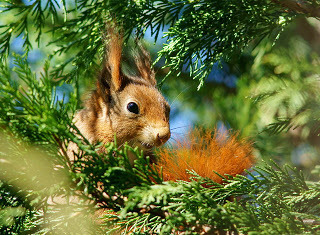
As a vegetarian myself, researching this post set me thinking about what makes some meats acceptable to eat, and others repulsive. What is your opinion? Why should it be OK to eat lamb or chicken, but we squirm at the idea of mole or parrot?Photo courtesy of British Wildlife Centre
Published on August 29, 2012 03:49
August 22, 2012
Unnatural Deaths
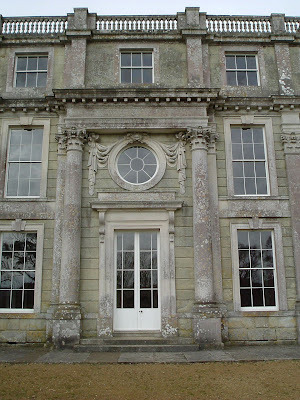 The main entrance - Appuldurcombe House - sadly behind the facade is a ruin,
The main entrance - Appuldurcombe House - sadly behind the facade is a ruin,the building destroyed by a World War II bomb. Q. What do a priest, John Smith and an heir to Appuldurcombe House have in common?
A. They all died unnatural deaths on the Isle of Wight.
This week I'm on holiday and my blog post was inspired by a recent ghost walk around Appuldurcombe House, near Wroxall. A monk (!) conducted the tour through the ruins and recounted some of the gory tales of unnatural death pertaining to the house in its heyday when it was the most important estate on the IOW (Isle of Wight).
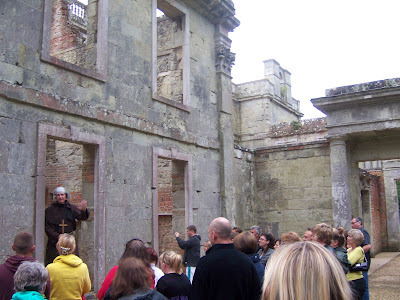 Sadly, the house is largely now ruins - destroyed by a WWII bomb.Appuldurcombe's history starts in the 16th century with a page to King Henry VII, called James Worsley, whose family originated in Lancashire. The boy Worsley was educated along side the future King Henry VIII. The tale goes that no person was allowed to harm an heir to the throne, so when the young Henry misbehaved, his tutors whipped his friends to make the prince feel guilty- it is from this practice that the expression 'whipping boy' originates. The future Henry VIII must have had quite a guilty conscience because when he became king he appointed James Worsley as Keeper of the Wardrobe, knighted him and gifted him a monastery that stood on the site of the current Appuldurcombe House. (On James' death he bequeathed his best gold chain to Henry VIII and his largest standing cup to Thomas Cromwell.)
Sadly, the house is largely now ruins - destroyed by a WWII bomb.Appuldurcombe's history starts in the 16th century with a page to King Henry VII, called James Worsley, whose family originated in Lancashire. The boy Worsley was educated along side the future King Henry VIII. The tale goes that no person was allowed to harm an heir to the throne, so when the young Henry misbehaved, his tutors whipped his friends to make the prince feel guilty- it is from this practice that the expression 'whipping boy' originates. The future Henry VIII must have had quite a guilty conscience because when he became king he appointed James Worsley as Keeper of the Wardrobe, knighted him and gifted him a monastery that stood on the site of the current Appuldurcombe House. (On James' death he bequeathed his best gold chain to Henry VIII and his largest standing cup to Thomas Cromwell.)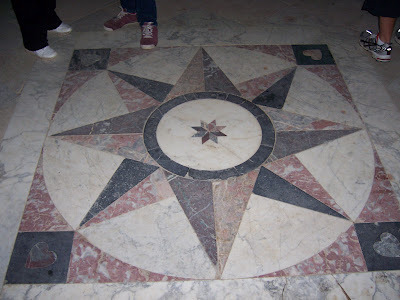 A marble floor under which 4 Worsley children are buried.
A marble floor under which 4 Worsley children are buried. Not the love hearts at the corner of the design : 2 blue and 2 pink, denoting 2 boys and 2 girls.But what of unnatural deaths?
Well, James Worsley had a son, Richard. Under King Henry VIII, one of the Worsley's responsibilities was to protect the IOW from French invasion. Indeed the King is said to have visited to inspect the state of local defences, and gifted his host a fine Holbein portrait of himself.
Richard organised regular military manoeuvres which included the use of live firearms. However one day it was raining and the gunpowder got wet. Richard's two sons took the damp powder to a gatehouse to let it dry out, unfortunately the barrel got too close to the fire and the whole lot exploded -demolished the gatehouse and killed 6 people including both of Richard's sons and heirs.
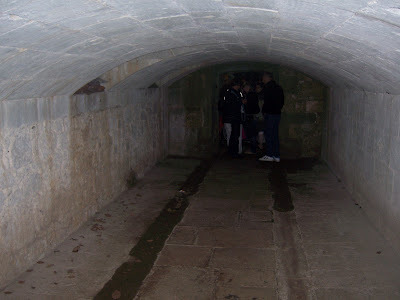 Part of the cellar network beneath Appuldurcombe House. Moving forward in time to the mid 1600's, we find the Worsley's were secret catholics at a time of persecution. The punishment for harbouring catholic priests was severe - a red hot poker up the derriere and so people went to great lengths to hide visiting cleris and those wishing to conduct mass had a number of secret hiding places or 'priest holes.' Appuldurcombe was no different and had a tunnel leading from the cellar to woodland 500 feet away. Unfortunately, the excavation of the tunnel followed a natural geological fault that dipped at one point and was prone to collecting water. This meant the escapee had to hold his breath, crawl underwater a few seconds before emerging on the other side.
Part of the cellar network beneath Appuldurcombe House. Moving forward in time to the mid 1600's, we find the Worsley's were secret catholics at a time of persecution. The punishment for harbouring catholic priests was severe - a red hot poker up the derriere and so people went to great lengths to hide visiting cleris and those wishing to conduct mass had a number of secret hiding places or 'priest holes.' Appuldurcombe was no different and had a tunnel leading from the cellar to woodland 500 feet away. Unfortunately, the excavation of the tunnel followed a natural geological fault that dipped at one point and was prone to collecting water. This meant the escapee had to hold his breath, crawl underwater a few seconds before emerging on the other side. 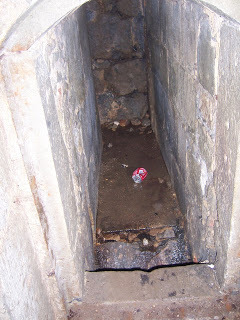 The entrance to the 'priest tunnel' within the cellars. One Father Ewan was not so lucky. He used the tunnel and was never seen again. It was assumed he'd got safely away into the woods and no one worried, until a while later a dreadful smell filled the cellars. It seems he drowned in the natural dip and it wasn’t until heavy rain and decaying body parts washed down the tunnel that anyone was any the wiser.
The entrance to the 'priest tunnel' within the cellars. One Father Ewan was not so lucky. He used the tunnel and was never seen again. It was assumed he'd got safely away into the woods and no one worried, until a while later a dreadful smell filled the cellars. It seems he drowned in the natural dip and it wasn’t until heavy rain and decaying body parts washed down the tunnel that anyone was any the wiser. 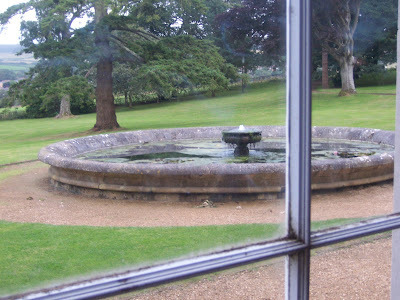 The ornamental pond into which John Smith was thrown and left to his fate. Our third unnatural death is that of a school boy, John Smith. By Victorian times the house had passed out of the Worsley's hands and for a short time became a hotel, and then a school. The Rev. Pound established "a college for young gentlemen." However, it seems his school was not a happy place and bullying was rife. One boy, John Smith, was mercilessly picked on because he was short. One freezing November night John's dormitory mates plotted to throw him in the large ornamental pond outside the main entrance. They had to break the ice to get him in, and worse still, he was unable to get out unaided. The pond is 8 ft deep at the centre and 5 ft deep at the edges, with a vertical lip that meant unless you were tall it was impossible to grasp the ledge to pull yourself out.
The ornamental pond into which John Smith was thrown and left to his fate. Our third unnatural death is that of a school boy, John Smith. By Victorian times the house had passed out of the Worsley's hands and for a short time became a hotel, and then a school. The Rev. Pound established "a college for young gentlemen." However, it seems his school was not a happy place and bullying was rife. One boy, John Smith, was mercilessly picked on because he was short. One freezing November night John's dormitory mates plotted to throw him in the large ornamental pond outside the main entrance. They had to break the ice to get him in, and worse still, he was unable to get out unaided. The pond is 8 ft deep at the centre and 5 ft deep at the edges, with a vertical lip that meant unless you were tall it was impossible to grasp the ledge to pull yourself out.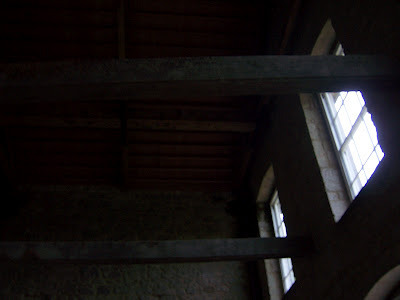 The room (now ruined) where John Smith hung himself. Poor John Smith was left in the freezing water and was only rescued when a master happened past. Despite this the bullying continued and a short while later, sadly John took his own life and hung himself.
The room (now ruined) where John Smith hung himself. Poor John Smith was left in the freezing water and was only rescued when a master happened past. Despite this the bullying continued and a short while later, sadly John took his own life and hung himself. 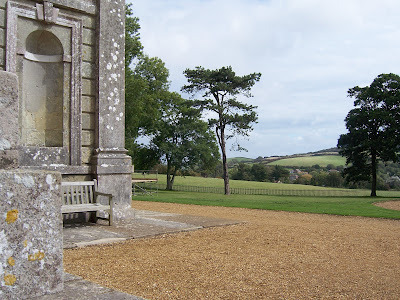 A hint of the splendour that once existed. And finally, much of the information for this post was obtained from a pamphlet printed by the Department of the Environment, Ancient Monuments and Historic Buildings Department, published in 1967. I found the leaflet in a tea-shop near Freshwater, selling second hand books. The cover price was 35p, but the tea-shop resold it for 3 GBP - strikes me that this is quite a good mark up. Anyone any idea what 35p from the 1960's is worth in today's money?
A hint of the splendour that once existed. And finally, much of the information for this post was obtained from a pamphlet printed by the Department of the Environment, Ancient Monuments and Historic Buildings Department, published in 1967. I found the leaflet in a tea-shop near Freshwater, selling second hand books. The cover price was 35p, but the tea-shop resold it for 3 GBP - strikes me that this is quite a good mark up. Anyone any idea what 35p from the 1960's is worth in today's money? 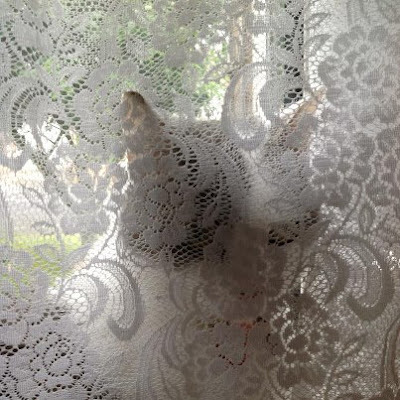 Widget- ghost or cat?
Widget- ghost or cat?
Published on August 22, 2012 04:15
August 15, 2012
My Guilty Secret - London Trivia #4
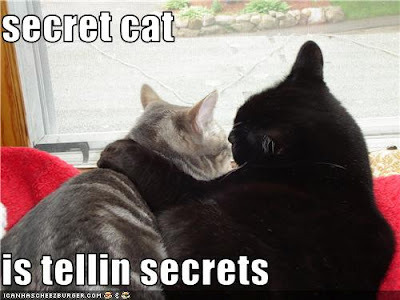 Photo courtesy of Cheezburger.comI have a guilty secret - I quite like watching 'Bargain Hunt' - (for my US friends, this is a daytime TV show where generally clueless couples buy trash from antique fairs with the aim of selling it at auction for profit. The couple that makes the most profit, or smallest loss, wins!) Hosted by the epitome of an English gentleman, Tim Wannocott, halfway through the show Tim visits a place of historical interest and on the occasion that inspired this post, he visited the Sir John Soanes museum London.
Photo courtesy of Cheezburger.comI have a guilty secret - I quite like watching 'Bargain Hunt' - (for my US friends, this is a daytime TV show where generally clueless couples buy trash from antique fairs with the aim of selling it at auction for profit. The couple that makes the most profit, or smallest loss, wins!) Hosted by the epitome of an English gentleman, Tim Wannocott, halfway through the show Tim visits a place of historical interest and on the occasion that inspired this post, he visited the Sir John Soanes museum London.  Tim Wonnacott - photo courtesy of the BBC.Sir John Soanes was the Georgian architect who designed the Bank of England, amongst other notable buildings. But what sparked my interest during Tim's segment, was the sheer eccentricity of Soanes home - which also doubled as a museum in his lifetime. Soanes was a collector of architectural artefacts and filled his house with antique marble fragments of statues and friezes, mainly from ancient Rome. From the glimpse I got on the TV it looked too interesting to miss and living close to London I went to visit.
Tim Wonnacott - photo courtesy of the BBC.Sir John Soanes was the Georgian architect who designed the Bank of England, amongst other notable buildings. But what sparked my interest during Tim's segment, was the sheer eccentricity of Soanes home - which also doubled as a museum in his lifetime. Soanes was a collector of architectural artefacts and filled his house with antique marble fragments of statues and friezes, mainly from ancient Rome. From the glimpse I got on the TV it looked too interesting to miss and living close to London I went to visit. 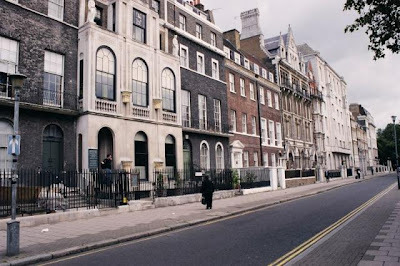 Soanes Museum - the cream coloured building to the left of the picture.Soanes Museum is at 12 - 14 Lincoln's Inn Fields, London and entry is free!
Soanes Museum - the cream coloured building to the left of the picture.Soanes Museum is at 12 - 14 Lincoln's Inn Fields, London and entry is free! Greek and Roman marbles line the stairwells, a full sized Egyptian sarcophagus in the basement, a room of Hogarth's mounted on hinged walls. In the basement, Soanes created an atmosphere reminiscent of catacombs or Roman burial chamber, of which the centre piece was the magnificent Egyptian sarcophagus of King Seti I; bought by Soanes when the British Museum refused to pay 2,000 pounds for it. With hieroglyphics as yet deciphered in his time, and a very important antiquity, Soanes celebrated the arrival of his new piece with three evening parties, illuminated by three hundred oil lamps and attended by nearly a thousand people.
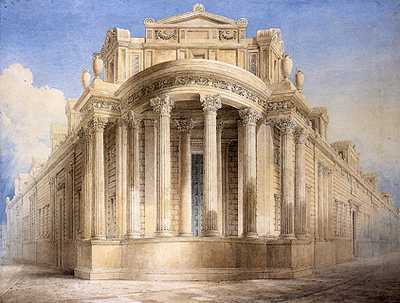 The Bank of England - designed by Sir John Soanes.Mrs Soanes must have had the patience of a saint to put up with the stamp of her husband's overwhelming personality, but by all accounts they were a happy couple. A mark of Soanes' eccentricity was his 'Monk's Parlour.' This was a downstairs room designed in a gothic fashion, with dark sombre colours and heavy furniture to illustrate the importance of light (or lack of it) in creating atmosphere. What is even more delightful is that when Soanes wanted to be alone he would claim:
The Bank of England - designed by Sir John Soanes.Mrs Soanes must have had the patience of a saint to put up with the stamp of her husband's overwhelming personality, but by all accounts they were a happy couple. A mark of Soanes' eccentricity was his 'Monk's Parlour.' This was a downstairs room designed in a gothic fashion, with dark sombre colours and heavy furniture to illustrate the importance of light (or lack of it) in creating atmosphere. What is even more delightful is that when Soanes wanted to be alone he would claim:"Padre Giovanni has come to visit," and disappear into the Monk's Parlour to take tea. However since Padre Giovanni was fictitious, actually a play on Soanes' own name 'John' - his visits were an excuse to enjoy solitude.
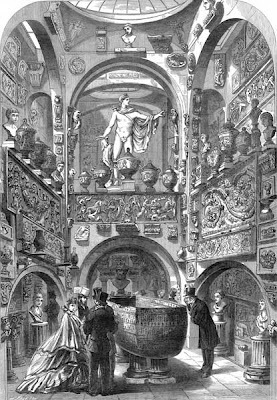 The sarcophogus in Soanes house - and yes it is as mad as this! I've gone a long way round the houses to say I'm proud that my 'guilty secret' inspired a visit to a place I hadn’t heard of before- and I feel less guilty as a result! Have you ever visited somewhere you saw on TV and were blown away by the experience? Do leave a comment and join the conversation!
The sarcophogus in Soanes house - and yes it is as mad as this! I've gone a long way round the houses to say I'm proud that my 'guilty secret' inspired a visit to a place I hadn’t heard of before- and I feel less guilty as a result! Have you ever visited somewhere you saw on TV and were blown away by the experience? Do leave a comment and join the conversation! 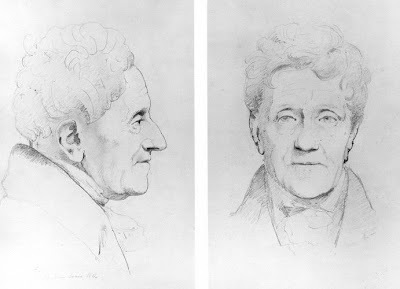 Portraits of Sir John Soanes by Sir Frances Chantry.
Portraits of Sir John Soanes by Sir Frances Chantry.
Published on August 15, 2012 03:18
'Familiar Felines.'
Following on from last weeks Halloween posting, today's blog post looks at the unwanted image of cats as the witches familiar - from the Norse Goddess Freya to lonely women in the middle ages.
The full Following on from last weeks Halloween posting, today's blog post looks at the unwanted image of cats as the witches familiar - from the Norse Goddess Freya to lonely women in the middle ages.
The full post can found at:
http://graceelliot-author.blogspot.com
...more
The full Following on from last weeks Halloween posting, today's blog post looks at the unwanted image of cats as the witches familiar - from the Norse Goddess Freya to lonely women in the middle ages.
The full post can found at:
http://graceelliot-author.blogspot.com
...more
- Grace Elliot's profile
- 156 followers



